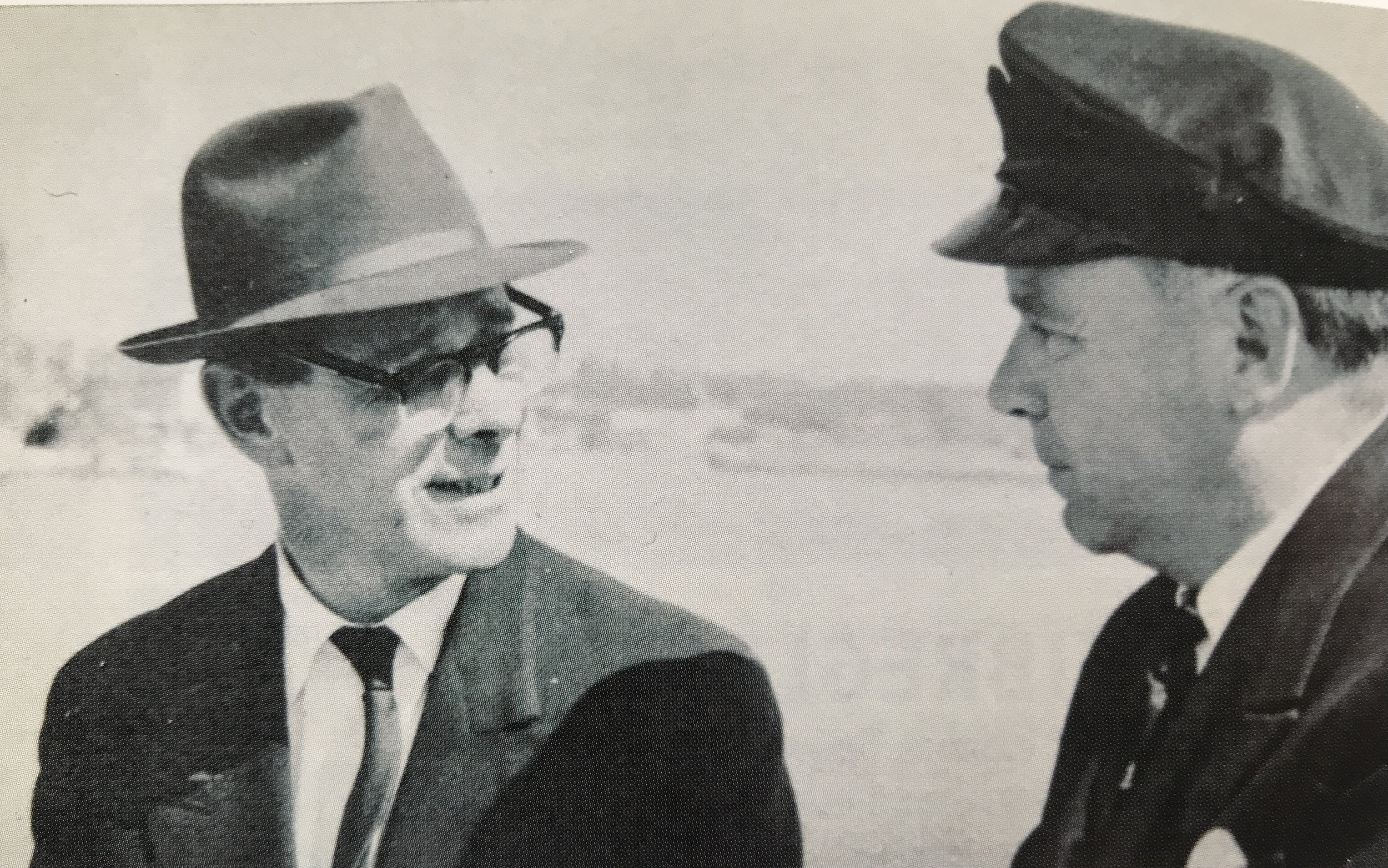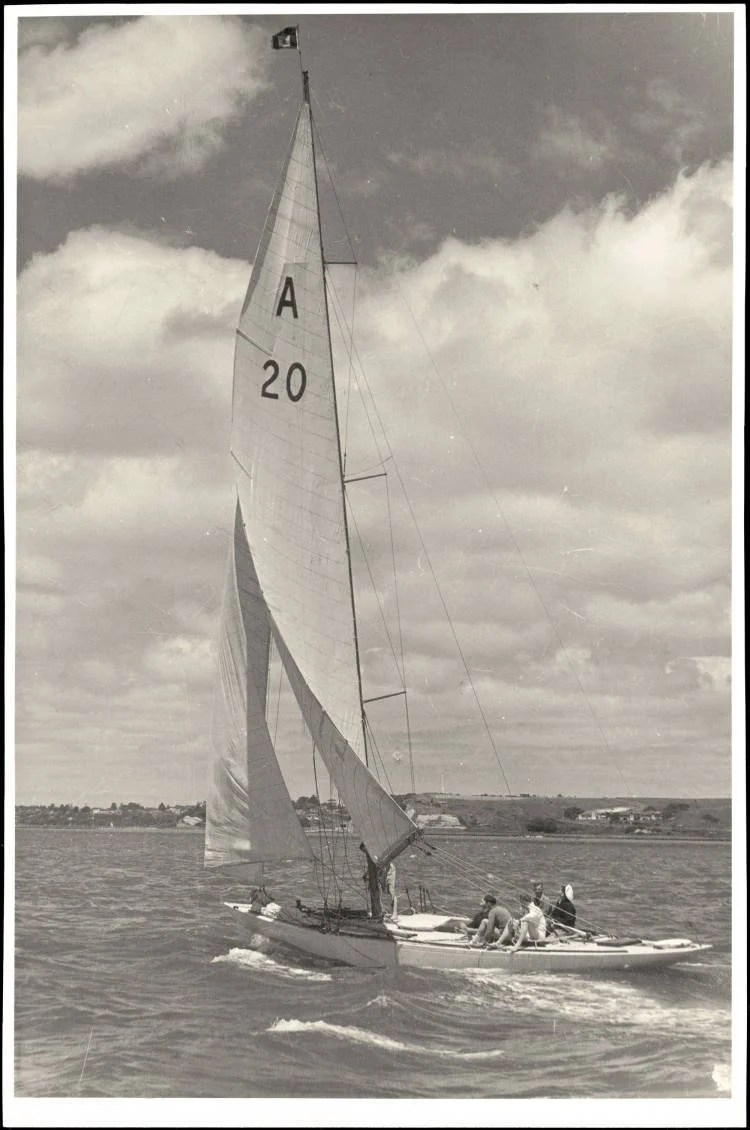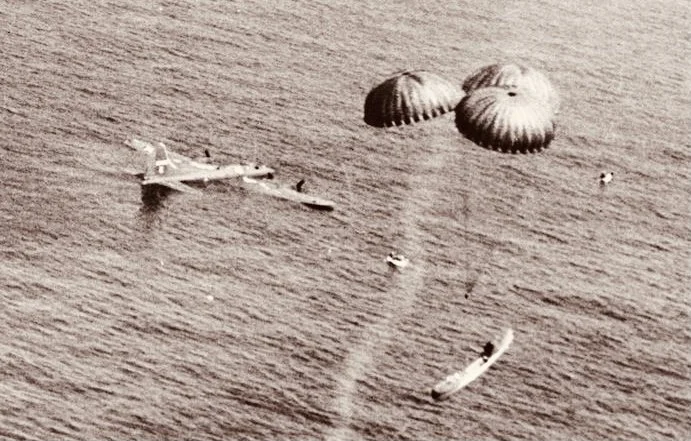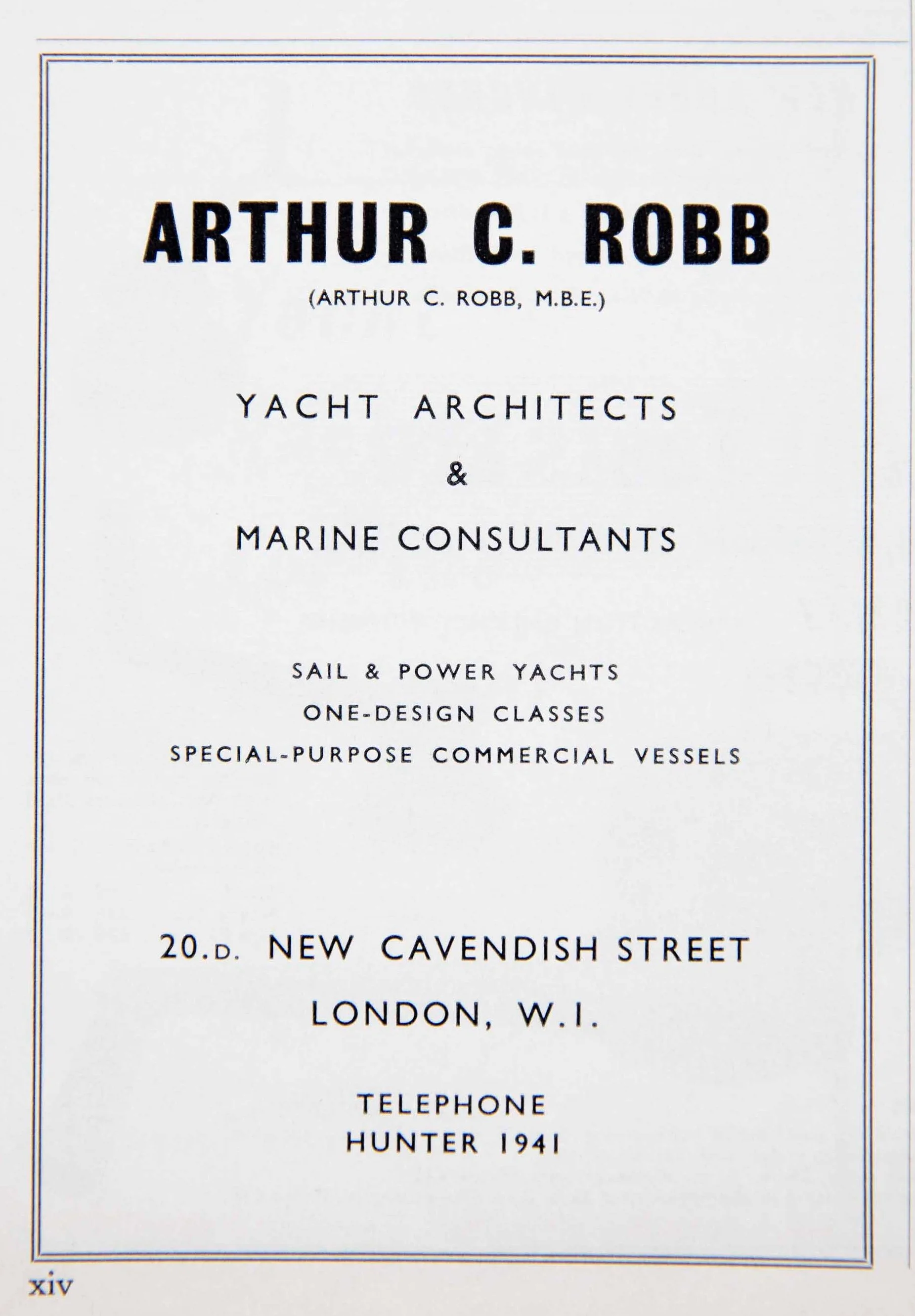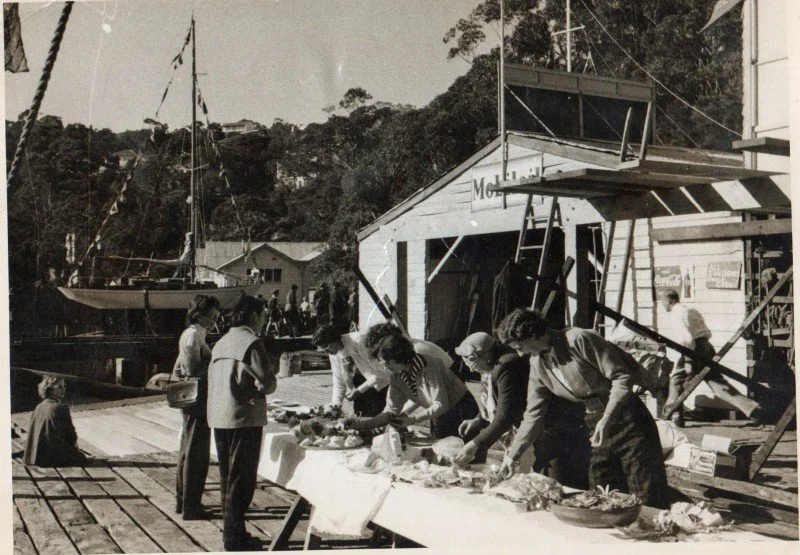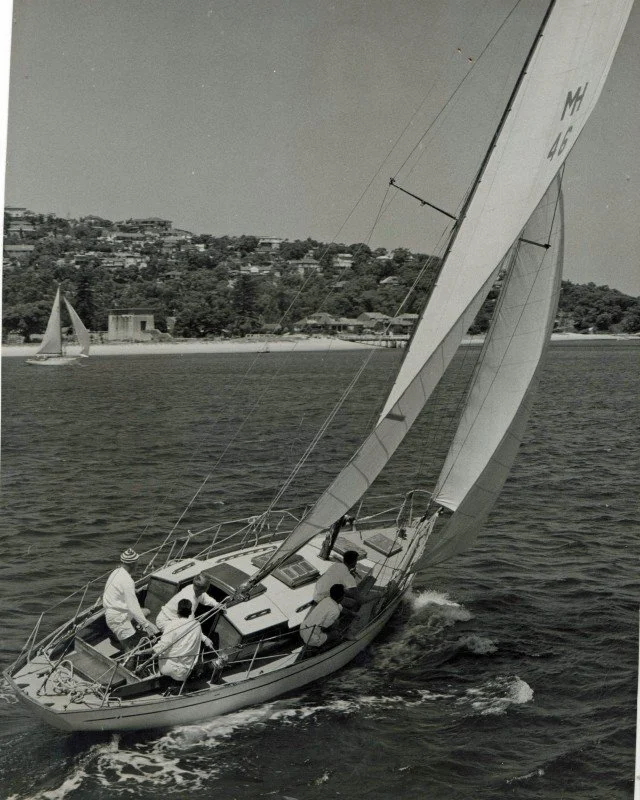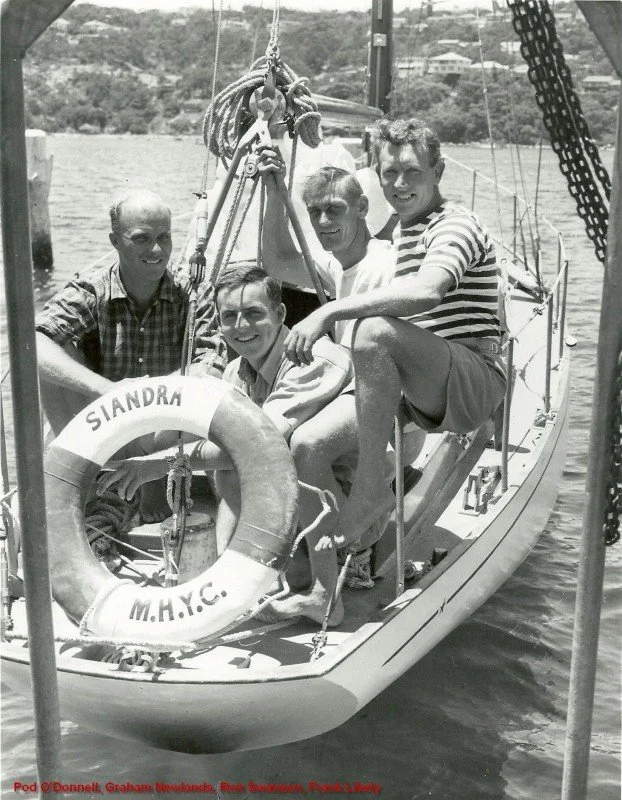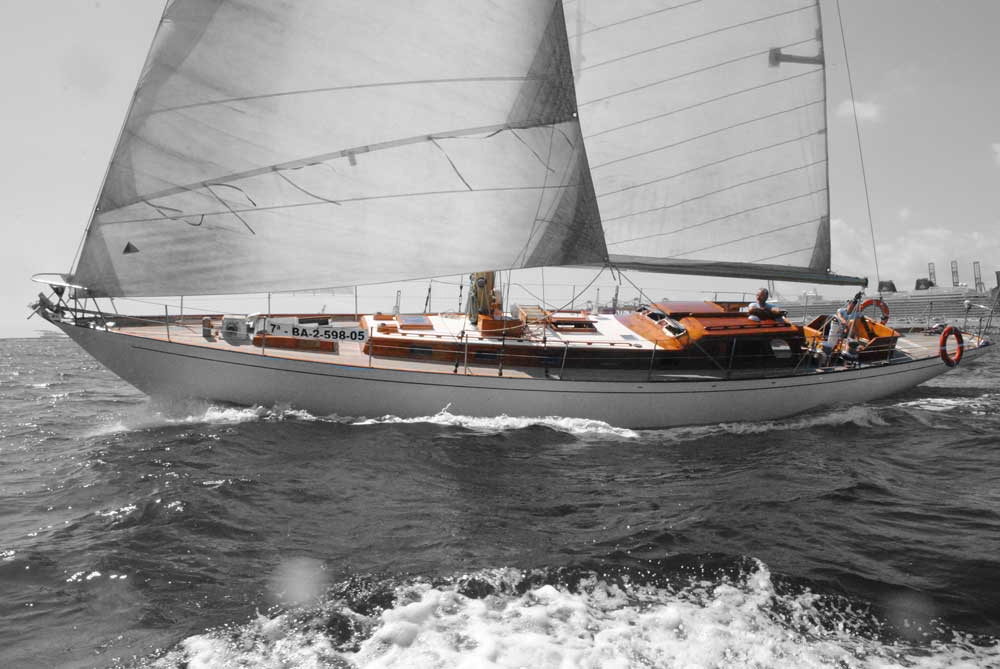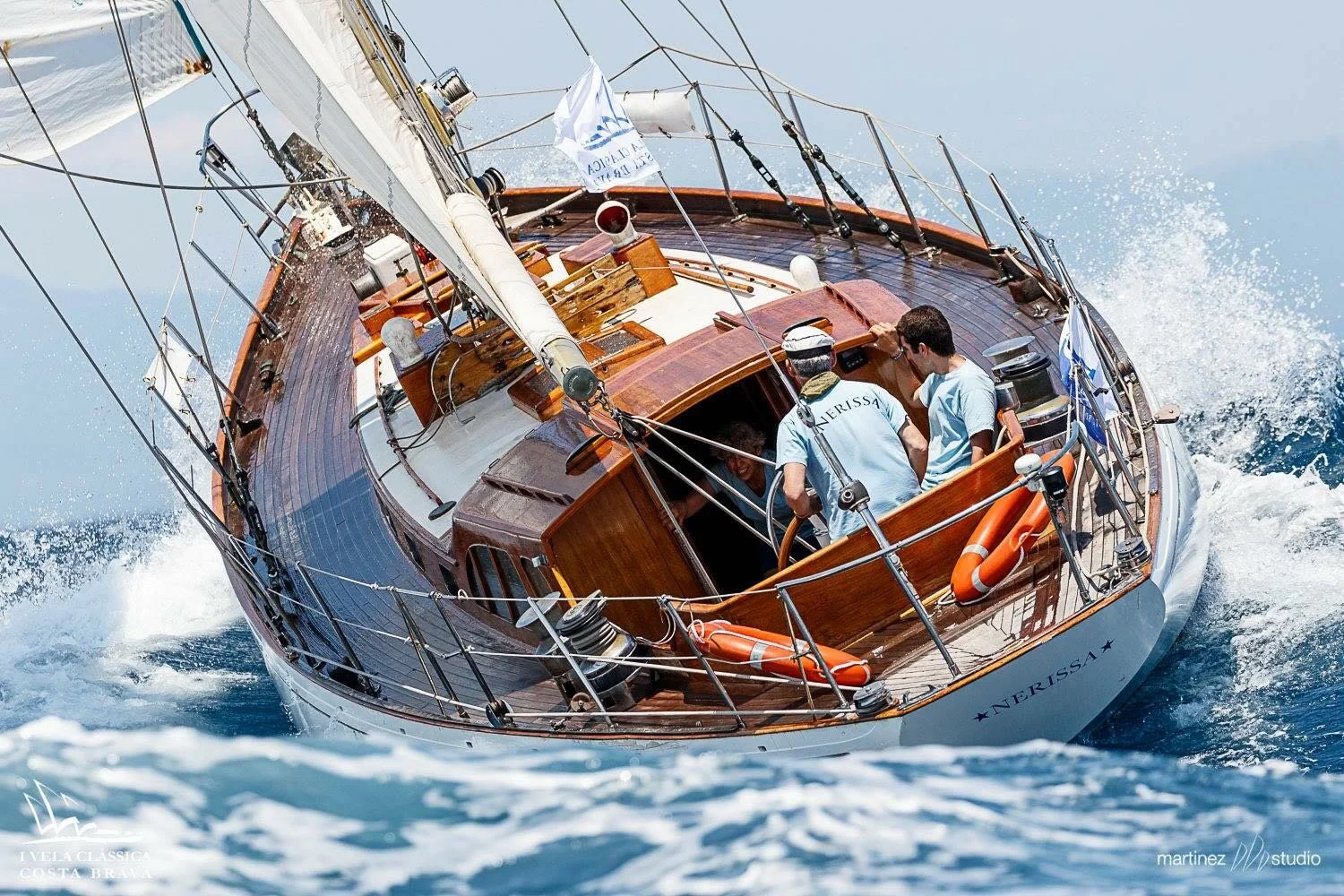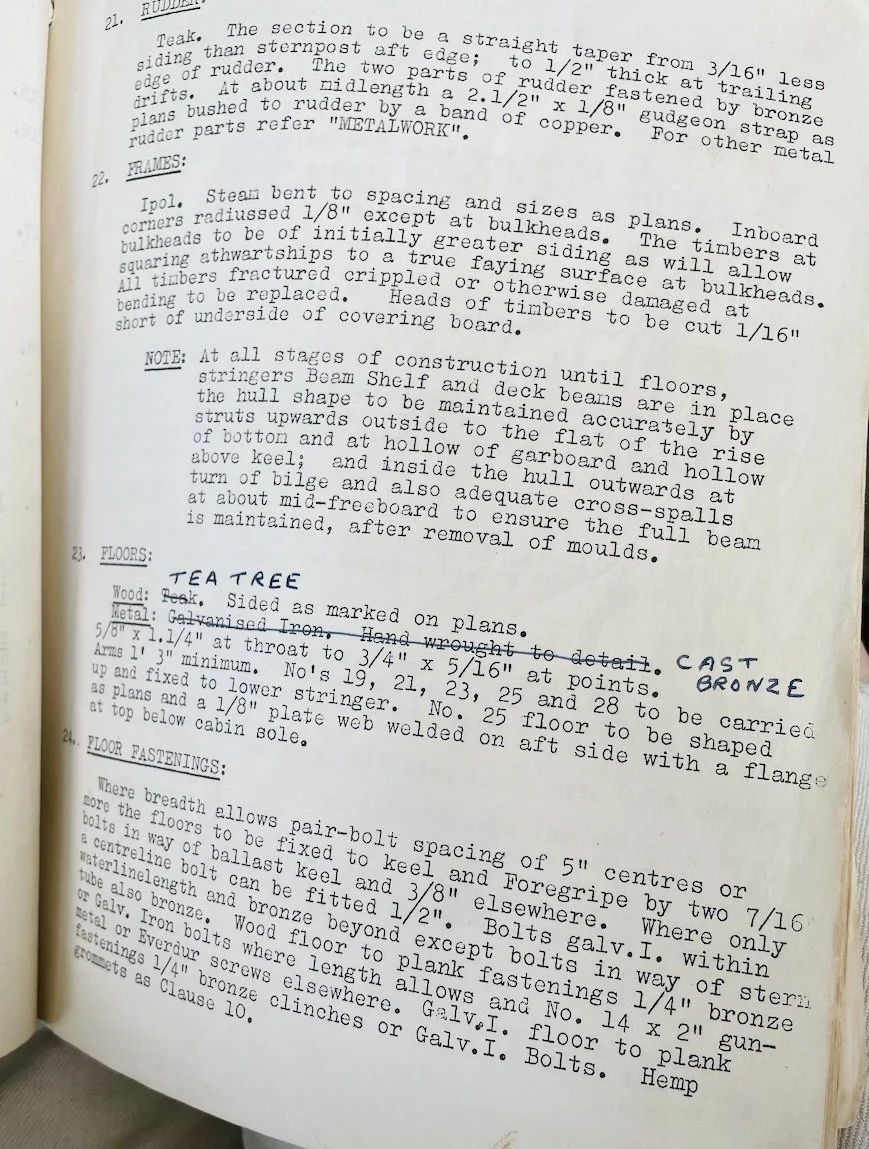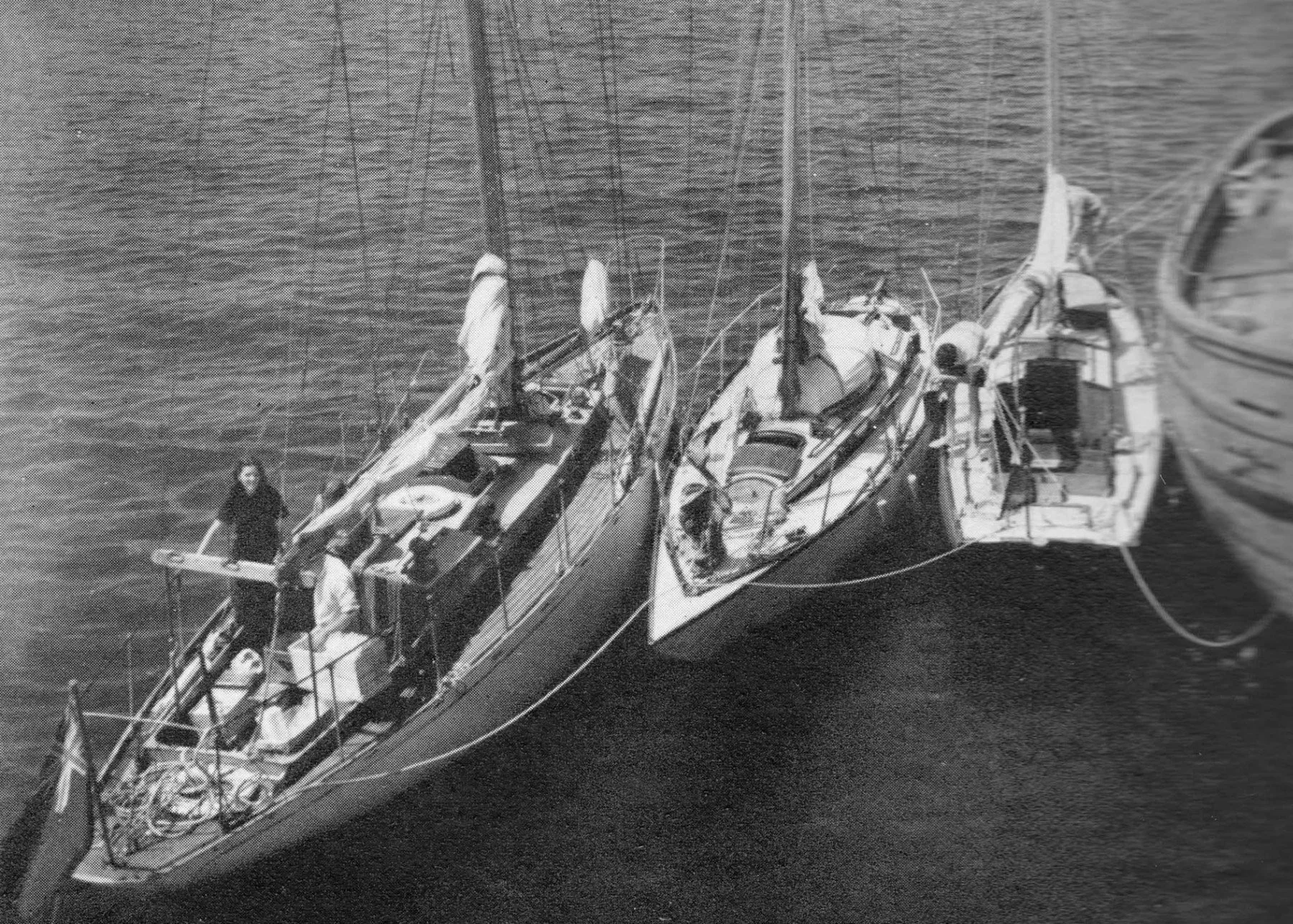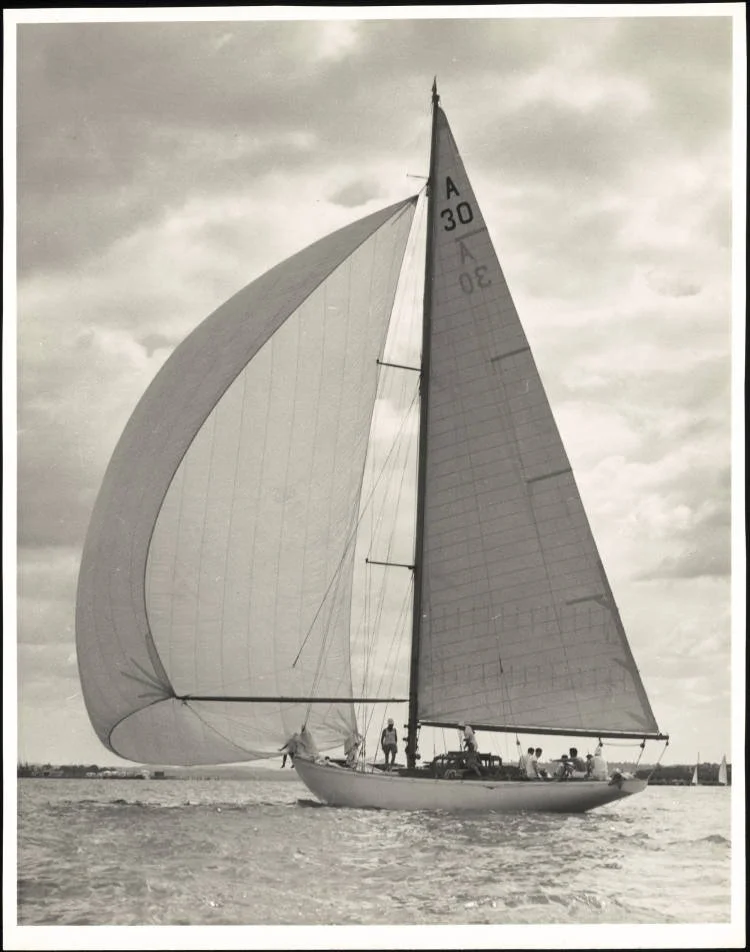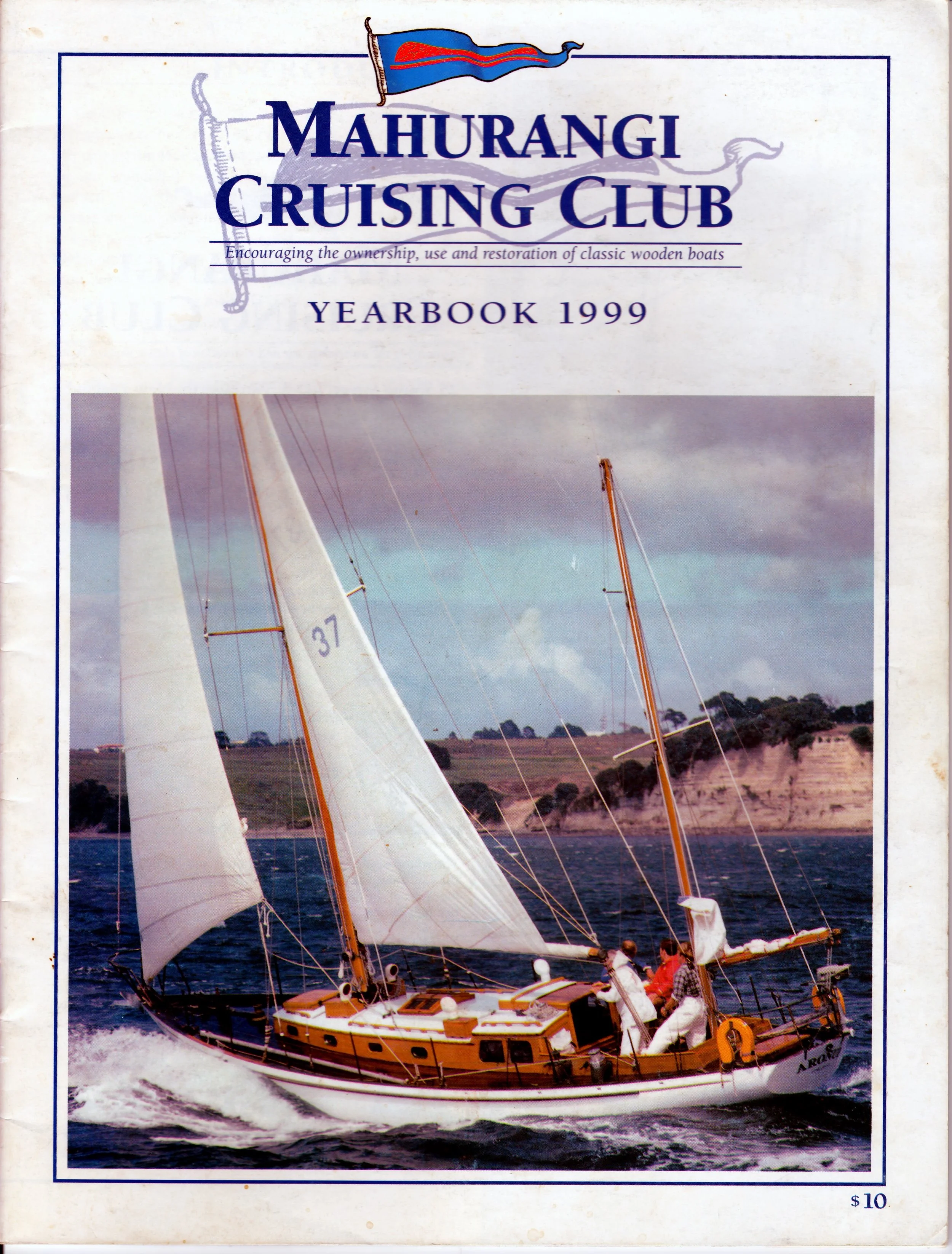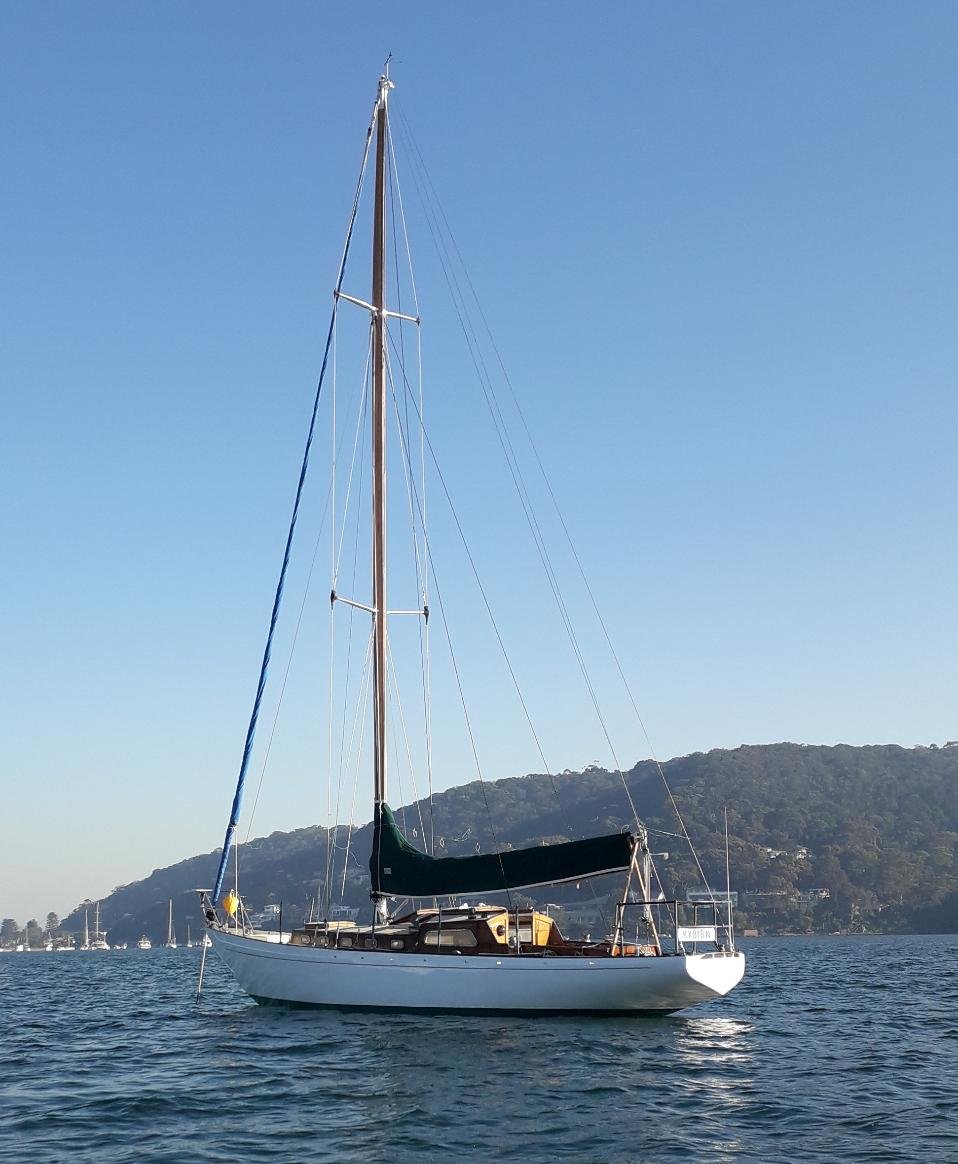Who is Arthur Robb?
By Charlie Salter
He’s a Very Famous New Zealander. This accomplished yacht designer defies expectation presenting as an ordinary 50’s man in his wool suit and Fedora. This is the only portrait we can find.
Naval Architect Arthur C Robb in conversation with a Flag Officer
THE NAVAL ARCHITECT
The design and shipbuilding companies started by Olin Stephens, Nathanael Herreshoff and Abeking & Rasmussen are still operating today, drawing on over 100 years of experience. However, some designers, widely celebrated and successful in their day are now largely unknown. These naval architects worked as independent consultants not aligned with a particular shipyard. This meant their work was limited to a lifetime rather than being continued. Many, like Arthur Robb, are ripe for research and a coffee table book.
It might be hard for many sailors to name an Australian naval architect. Melbourne had Charlie Peel designing and building for some 50 years from the 1890’s. Sydney has generations of the Halvorsen family working from the 1920’s as both designers and boatbuilders and everyone knowns Ben Lexcen from the 1980’s. The closest career story to Arthur Robb’s would be Alan Payne, born in England in 1921 then migrating to Australia in 1925 with his family. He worked at RAN Cockatoo Island Dockyard while training as a naval architect at Sydney Tech. After graduating he set up practice in 1946 overlooking Double Bay. Payne had success with dinghies like the Payne Mortlock Canoe, Sydney Hobart boats in the 1950’s and went on to design the 1962 America’s Cup challenger GRETEL for Frank Packer.
ARTHUR C ROBB
Like Payne, Arthur Cecil Robb started as an independent naval architect in London at the end of the war. By the 1950’s his reputation was already secure earning commissions while selling his standard class designs in the US and Australia. Many Robb boats are still cherished and sailing.
It’s hard to find much personal information on Robb. His archive is held at Mystic Seaport Museum in Connecticut and has a short bio in their Manuscripts Collection. Stebbings the UK boatbuilder has a few notes in their archive and Jenni Mence covers what’s known in her new book K CLASS – THE HAURAKI GULF’S ICONIC RACER-CRUISER, SWS 11 November. We’ll try to pull these together.
Robb was born in 1908 at Hawkes Bay on the north island of New Zealand. He came from a farming and sailing background and gained considerable local fame as a helmsman. As a junior he had a good deal of talent as a designer and builder of small yachts and dinghies. The family may have been living in Auckland as Robb is claimed by a primary school in Devonport on the North Shore. A curious reference in a local newspaper (North Shore Advertiser) dated 1962 has ACR as “Former Stanley Bay School pupil designing UK’s America’s Cup Challenger”. What might have been with Payne v Robb competing to challenge WEATHERLY in 1962. There are no records of a Robb 12m design discovered so far.
Robb chose to go to Great Britain in the early 1930’s to study boatbuilding and naval architecture. After doing odd-jobs, he became yard manager at Morris and Lorimers Boatbuilders at Sandbank, Argyll, Scotland. ACR continued sailing on 6 and 8 metre class yachts while entering design competitions around the world. He was encouraged to make a living as a yacht designer by Herbert Stone, Editor of Yachting (USA) after Stone saw one of ACR’s designs submitted for their competitions.
TAMATEA was the first Robb yacht built in his native New Zealand around 1937. She’s on the cover of Fred Norris’ book Arthur C Robb MBE, A Very Famous New Zealander. We are pretty sure this boat is designed to the International 8 metre rule following Robb’s experience in the UK. TAMATEA was part of the New Zealand classic fleet for 60 years but lost to fire in 2002.
TAMATEA A20 Hauraki Gulf, Auckland
THE AIRBORNE LIFEBOAT
ABL undergoing tests in the Solent
At the outbreak of the war in 1939, Robb joined the Royal Navy Volunteer Reserve, rising to the rank of Lieutenant Commander. The adaptable ACR worked in both the Admiralty and Air Ministry collaborating with the very inventive dinghy designer Uffa Fox to develop an airborne lifeboat. Brilliant English scientists, academics and eccentrics often underpinned military inventions. Think of the engineer Barnes Wallis’ dam busting skipping bomb and the mathematician Alan Turing breaking the German Enigma cipher code.
Trained pilots and air crew were an extremely valuable resource. The idea was to drop a rescue craft by parachute to a downed aircraft crew who would not survive in the cold North Sea. The craft had to be big enough to carry a US bomber crew of 10 persons and shaped to fit under the fuselage of various aircraft. It needed to be lightweight yet incredibly strong to survive deployment of the parachutes and a water impact, then be self-righting, unsinkable and operable by an inexperienced crew. Uffa Fox with other RAF officers, including Robb designed the first ABL in 1942. It was built from double skin mahogany with waterproofed fabric in-between. To ensure the craft was not pushed back to an occupied coast by wind and tides, a pair of 2-stroke Vincent motorcycle engines was fitted together with a set of sails and a beginner’s guide to sailing (printed on waterproof paper). The ABL could hold course long enough to be picked up by a fast RAF rescue launch. See the full story at Uffa Airborne Lifeboat.
ABL being dropped from an Avro Lancaster
ABL on its way to a ditched Boeing B-17 Flying Fortress
After the war Robb started practice in central London as a Yacht Architect & Marine Consultant. He worked with his wife Susan who handled contracts with prospective yacht owners and negotiations with suppliers of materials and equipment for the yachts. The Mystic Seaport Museum biography notes:
“The collection consists of papers concerning the designs that Arthur Robb made for cruising/racing yachts like the LION, the ROBB 35 and the RADIANT one-design classes, as well as design data for specific sailing craft for individual owners. The careful mathematical figures and many pages of design details, displacement ratios and sail area plans give a picture of the meticulous planning that he did before a yacht was allowed to be built. Robb’s office paid attention with details of firms that could supply the best winches, rigging, masts, sails and other equipment. He carefully followed the progress of his yachts once they were launched, and saw to changes in design, mast placement, type of keel, etc. He took interest in racing, making notes about the ratings and records of his and other yachts entered in those races”.
Robb had a successful career and was well known for his one-design cruiser/racers. His boats were built throughout the world, but particularly in the United States. ACR produced a significant catalogue of boats in a short 25 year period after the war. He was awarded Member of the British Empire that was proudly added to the office livery. Let’s assume for services to sailing and naval architecture. He died a relatively young designer after a long illness in London in 1969. Here are some of the boats.
LION CLASS
The Lion Class is a 35’ 8” masthead sloop, licensed to owners and shipwrights all over the world in the 1950’s and 60’s. See CHEOY LEE SHIPYARDS SWS 28 Oct. Three Lions, SIANDRA, KAIYU, MALOHI were built at the same time in Sydney between 1954-56. Finding suitable materials 10 years after the war was no simple thing. The three owners purchased eleven 40’ white beech logs from Wauchope, a timber town near Port Macquarie. The logs were railed back to Sydney where they were milled and planed for full length planks. Ron Swanson built SIANDRA for Graham Newland at the back of Newland’s engineering factory in Crows Nest. She became one of Middle Harbour’s most famous yachts, winning the Sydney Hobart in 1958 and 1960, crewed both times by Newland, Ron Swanson, Frank Likely and Pod O’Donnell. Ron Swanson with his brothers Ken and Jim went on to start their own design and shipbuilding business.
SIANDRA launch day at Frank Likely’s boatyard 1956. We love a buffet
SIANDRA at the Spit circa 1958
Winning S2H crew 1958. Pod O’Donnell, Graham Newland, Ron Swanson, Frank Likely
SIANDRA coming up the Derwent to win the 1960 Sydney Hobart
ELVIS CATCHES LION
The Classic Yacht Assoc of Australia’s historian and handicapper, Peter Costolloe writes;
By the late 1950’s Lions were quite famous. Just as a side note the Elvis Presley movie Girls! Girls! Girls! from 1962 has at least 3 Lions used throughout the movie. Elvis covets the Lion along with Stella Stevens. He’s the boat hand for a wealthy yachty who leaves the boat to him in his will. At the beginning of the movie about 20 girls pile onto the Lion while its sitting at the dock...! The waterline suffers somewhat despite having beautiful streamlined waifs aboard. There's a bit of skulduggery involved but in the end Elvis gets the girl and the boat. There are a couple of scary moments where the Lion runs over a tinny while Elvis is saving Stella and if you watch carefully things didn't quite go to plan. I believe Stella was injured and there must have been some yacht damage, when Elvis did his own stunts.
SIANDRA crew performing their own stunts. Seacraft 1958
The owner of the Melbourne Lion SIMBA, sent SWS a sad tale that KAIYU was recently taken to the tip by the NSW Maritime Services Board. She was moored in Careel Bay in a sad state. RMS towed it to their mooring at Quays Marine, Church Point, where it sank. She was re-floated and at least two reputable shipyards offered to save her but RMS refused. KAIYU was put on a low-loader and sent to Kimbricki Tip in Terry Hills in August 2019.
BESPOKE BOATS
There are many standard Robb designs as well as one-off bespoke sloops and yawls with centreboards or keels commissioned by clients such as NERISSA, ROBB ROY and RAPPAREE .
NERISSA built in Italy in 1965. Owned by Count Cinzano (Martini)
NERISSA. Portami un Negroni per favore
ROB ROY
RAPPAREE
PRINCESS CLASS
AKALA is a 37’ Robb Princess Class built in 1963 that has competed in the Sydney Hobart multiple times. She’s been with the McNeice family since 1989 and still sails with the Melbourne classic fleet.
The Princess Class specification shows meticulous instructions for the shipwright. The materials nominated suggest this was a standard document for Cheoy Lee Shipyards using teak and Ipol frames.
David McNeice sent us the Sydney Hobart feature in the Australian Women’s Weekly from Dec. 1969. Clockwise from top left: Ted Kaufman on MERCEDES III (still with the Melbourne classic fleet), PROSPECT of WHITBY, the English Admiral’s Cup boat owned by Arthur Slater, AKALA with John Bleakley Rear Commodore CYC and “Mrs Bill MacRae, cook on her husband’s ketch ENID”. This was the year when the English did the double. Max Aitken’s CRUSADE took line honours and Edward Heath’s little S&S MORNING CLOUD, won on handicap.
AKALA coming up the Derwent. Sydney Hobart 1964
Robb Princess Class specification. Courtesy David McNeice
Robb Princess Class specification. Courtesy David McNeice
AKALA featured in the Women’s Weekly Dec 1969. National Library Australia
AKALA in Geelong after recent cockpit refurb. November 2021
UOMIE
UOMIE is a UK built 38’ cutter. After completing the Fastnet and Bermuda races, she was shipped out from England for the 1958 Sydney Hobart. Classic Yacht Assoc Australia’s Peter Costolloe has a remarkable network. He sent SWS the following email from UOMIE’s current owner restoring her in Germany. International correspondence hosted by Google Translate is truly wonderful “…..she came to me like a dog”.
I’m an architect by trade but have sailed quite a lot for many years on the Mediterranean classic circuit, mainly as race navigator of larger classic yachts, but also as deckhand and watch-captain on voyages and deliveries. I’ve sailed a few years on the Plym built Knud Reimers Yawl AGNETA.
Uomie is my own project and she came to me like a dog. I had been looking at her for some time. She was in disastrous condition and lying in Finland where prices are very high. In the end the owner offered her at a low price and I started the rescue project in Poland, with lower prices but other problems. She is now in Germany and getting better and better. Kindly Lukas Riembold
UOMIE Sydney Hobart Race Program CYCA 1958
MOKOIA
MOKOIA was the boat that started the SWS research on this interesting designer. Chad Thomson of the Classic Yacht Association of New Zealand emailed SWS:
The Royal New Zealand Yacht Squadron had a design competition in the mid 1940s to come up with a loose one-design keeler for fast cruising and racing for Squadron members returning home after the war. Arthur C Robb of 39 Vandon Court, Westminster, submitted the winning design named MOKOIA dated December 1944. Local competitors decided their designs to be better so Bob Stewart’s HELEN was the first one built. This started the K Class yachts in Jenni Mance’s beautiful book. She notes ... many of the earlier TAMATEA’s features reappeared in the drawings for MOKOIA. This also shows Robb was designing well before the end of the war in Europe in May 1945. The yacht was never built in New Zealand.
MOKOIA, was eventually built by Stebbings in the UK in 1948 and modified for the client James Murray to suit RORC rules for offshore racing. She’s 37’ 10” LOA with 8’ 11” beam. See REIMERS & ROBB SWS 2nd September. The Watson family kept her on the Clyde from the 1950’s until 1972 when she was sold and sailed to Australia and kept on Victoria’s Gippsland Lakes. She was then sold to Hobart. In 1998 she was sold again and is now moored in Lake Macquarie NSW, ready for restoration.
MOKOIA in Bermuda before transatlantic race 1950. Adlard Coles North Atlantic
KAHURANGI
KAHURANGI is a 62’ x 12’ cutter. She was built with triple planked Kauri in 1952 by Percy Vos Ltd Auckland. She’s designed to the 12 metre Class rule and raced for many years in the Hauraki Gulf. She’s now doing charter work based in Santa Cruz de Tenerife in the Canary Islands.
KAHURANGI A30 Hauraki Gulf 1953
RAMROD
RAMROD was commissioned by Selwyn Slater as an RORC offshore racer. Slater was the original owner of UOMIE.
RAMROD in the Solent
The DARING
After the war, Robb maintained his interest in Olympic and tight competitive sailing from his pre-war knowledge of 6 & 8 metre boats. When the 6 metre keelboat was replaced by the 5.5 metre for the Helsinki Olympics for 1952, Robb got to work.
The Olympic 5.5 Class uses a rating formula of inputs for length, displacement and sail area. Yachts are not identical but must comply. Unlike a One-design Class this leaves room for the designer. Charles Nicholson (of Camper & Nicholsons) had adapted the expensive 6 metre boat in 1937 and a rating formula was adopted in 1949 ready for Helsinki. Robb designed the UK 5.5 metre representative VISION for the 1956 Olympics in Melbourne. They won silver on the waters of Hobson’s Bay. The class regatta was sailed from RYCV in Williamstown.
Rob followed with the Daring for close Corinthian racing. She’s a One-Design keelboat based on his 5.5 metre VISION with a fractional rig, LOA of 32’ 6” and beam of 6’ 6”. The first boat was built in 1961. Construction is GRP, with some older yachts possessing original wooden decks. The enthusiasm and support for the class produced a new moulded hull in 2008 to match the original lines with a redesigned ergonomic deck and cockpit. Older boats could change to a new hull while retaining their original number, rigging, keel and name. 30 Darings are still based in Cowes on the Isle of Wight for seasonal racing on the Solent. Classic sailors from Melbourne, travelling in pre-pandemic Europe, were able to lease a Daring to compete at Cowes Week. Boat names almost always start with “D” for DAUNTLESS, DARLING, DECOY, DYNAMITE, DING DONG and DERRING-DO.
Daring DOUBLE-KNOT at Cowes Week 2015. Photo Tim Jeffreys
INVITATION
Southern Wooden Boat Sailing invites our Kiwi comrades to fill in the gaps about Arthur C Robb. We look forward to your comments.
PHOTO Credits
Tamatea & Kahurangi. Auckland Council Libraries. Buchanan Collection
Siandra. Boat Geneology
ARONUI - See Steve Horsley’s comment below
EOS - see Malcolm Lambe’s comment below
PALANA. See Sean Hogben’s comment below

